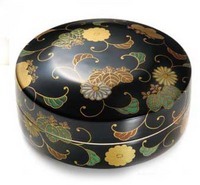

Total:131items
- Pottery & Porcelain (18)
- Koshu Kimen Gawara: Koshu Tile with a Devil’s Face
- Hasami Yaki: Hasami Porcelain
- Kiyomizu Yaki: Kyo style ceramics, Kiyomizu ware
- Otani Yaki: Otani Pottery
- Izushi Yaki: Izushi Porcelain
- Onta-yaki: Onta Pottery
- Takahama Yaki: Takahama Porcelain
- Mushiake- Yaki: Mushiake ware
- Kikuma-Gawara: Kikuma Roof-Tile
- Zeze-Yaki: Zeze ware
- TsutsumiYaki: Tsutsumi Pottery
- Hira Shimizu Yaki: Hira Shimizu Ware
- Tajima Banko Yaki: Tajima Banko Pottery
- Shidoro-Yaki: Shidoro Ware
- Amakusa Tojiki: Amakusa ware
- Shibukusa-yaki: Shibukusa ware
- Karatsu Yaki : Karatsu Ware
- Satsuma-yaki : Satsuma Ware
- Lacquerware (4)
- Glasswork (2)
- Wood & Bamboo Work (19)
- Leather Work (1)
- Papermaking (13)
- Textile (20)
- Dyeing products (5)
- Masonry (1)
- Metal Work (11)
- Stationery (4)
- Livingware (3)
- Accessory (4)
- Toys & Entertainment (14)
- Interior (2)
- Other crafts (10)

 |
Main Production Site:Kyoto |
 《Characteristics》
《Characteristics》Pottery and porcelain made in Kyoto is generally known as Kyo-style ceramics, Kiyomizu ware. The splendor and refined elegance of Kyo-style ceramics, Kiyomizu ware is created based on sophisticated design and various proficient skills. History of pottery and porcelain in Kyoto started more than 1,200 years ago, in Nara period. A Buddhist preist, Gyoki built a kiln and made earthenware in Seikanji. Now the ruins of the temple is called "Chawan-zaka".
Kyo-style ceramics, Kiyomizu ware products are mostly handmade and the feature of that is in wide variety in small quantity.
Traditional Craft Officialy Designated by Minister of Economy, Trade and Industry
Articles by : Federation of Kyo Pottery and Porcilain Cooperatives
Translation: Yoshiko Nagao
| Materials | Ceramics, Porcelain |
|---|---|
| Crafting Processes | 1. Wedging
Wedge a lump of clay well to remove air bubbles and make the texture even. 2. Throwing Place the clay on the turning plate and form using centrifugal force. This process requires high proficiency. 3. Trimming Trim the half-dried clay with a metal spatula. 4. Bisque(Biscuit) firing Bisque(Biscuit) firing is done at a low temperature between 600-800 degrees Celsius in order to strengthen the piece before glazing and painting, the latter steps. 5. Underglaze painting Draw a design on the bisque-fired piece with underglaze color or mineral pigments, such as asbolite or iron oxide, using a writing brush. 6. Glazing Coat the piece with glaze (for transparent color, shiny color, mat colors and so on) The color of the glaze will come out after calcination process. 7. Glost Firing(Final firing) Fire the piece after glazing at high temperature between 1,200-1,300 degrees Celsius. 8. Overglaze and overglaze firing Color the piece with metal pigments such as oxidized gold, silver and bronze for perfect finish. Then fire again at low temperature. 9. Finally complete |
| History | Ninsei Nonomura is a noteworthy master craftsman from the early history of Kyo-style ceramics. Ninsei's decorative overglazed enamel ceramics gave impact on ceramics styles all over Japan. The impact was so great that Kyo ceramics style had drastically changed - the previous style, called "Utsushimono" had been shifted to "Iromono", which had diversity of designs and colors.
Some time after, appeared Kenzan Ogata. Kenzan was a younger brother of the painter, Korin Ogata. The brothers co-created many splendid pieces of work - paint was done by Korin, and calligraphy by Kenzan. During mid Edo period, a new Kyo ceramics movement began. The trend of ceramic art moved to porcelain. Imari porcelain flourished in west Japan, and Eisen Okuda, another master craftsman in Kyoto emerged. Not only did Eisen brought about a new wave of porcelain to Kyo-style, but also raised many many excellent disciples. Mokubei Aoki, one of Eisen's disciples, Kenzan and Ninsei are honored as "The three greatest master craftsmen of Kyo ceramics". Mokubei learnt manufacturing process of porcelain from Eisen, which led him to a number of aristic pieces. After Meiji period, production volume increased according to modernization of the manufacturing process. Since then Kyo-style ceramics・Kiyomizu ware became important exports of Japan. Also, not just clinging to the tradition they had taken over, new originality of Kyo-style ceramics was made, combined with new technologies from foreign countries. After the war, more modernization has been made to management, eco-friendly facilities and so on. However, its high quality and artistic nature will never vanish. Tradition of the splendid ceramics will be kept with the policy of "in wide variety in small quantity". |
| Related URL | http://www.kyoyaki.com/ |
◆Exhibition / Showcase
Kyoto Traditional Industry Foundation Kyoto Museum of Traditional Crafts
Opening hours : 9:00am - 17:00pm
Closed : 8/15, 8/16, 12/29-1/3
Tel : 075-762-2670 Fax: 075-761-7121
Address :
B1F Miyakomesse, 9-1 Okazaki Seishoji-cho, Sakyo-ku, Kyoto-shi, 606-8343, Japan



